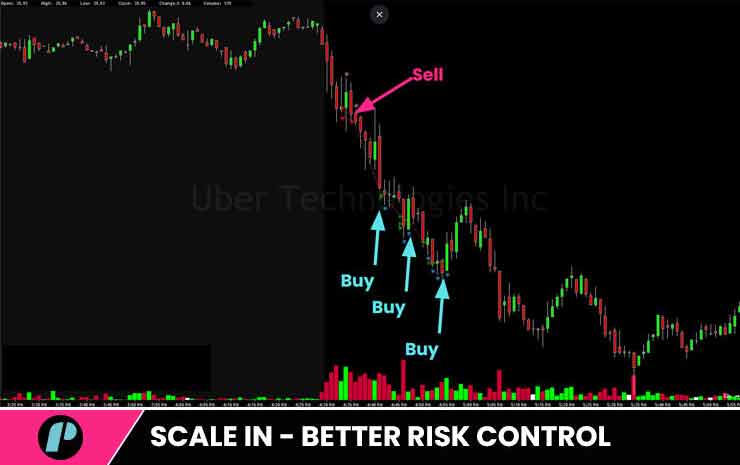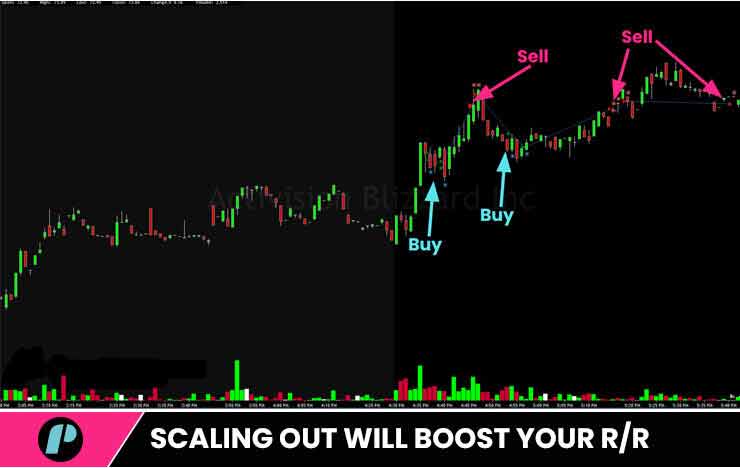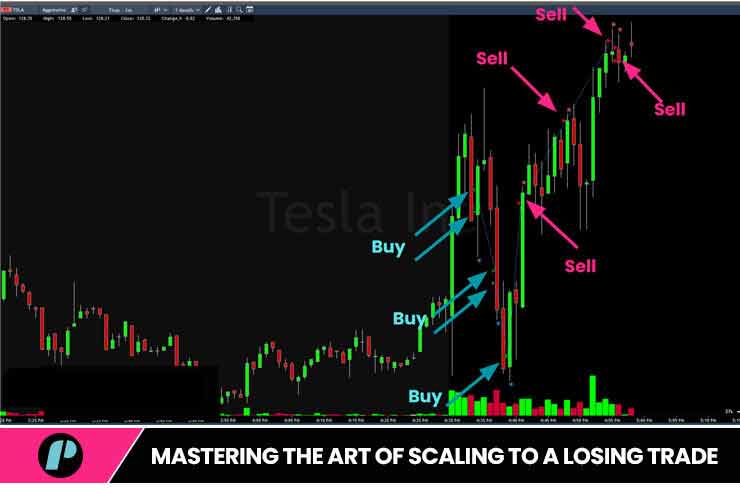
Introduction
As a stock trader, the strategies that you choose to (or not to) implement can massively influence your success. Understanding and applying effectively the techniques of scaling in and scaling out of trades, for example, could be a useful skill for anyone looking to improve their trading performance.
In today’s article, we’ll deep dive into the processes, characteristics, and potential benefits of scaling in and out of both winning and losing trades.
Scaling In Winning Trades
Scaling in is a method where a trader incrementally increases their position size in a stock as it moves in the trader’s favor.
The primary advantage of scaling into a winning position is to manage risk effectively.
By gradually increasing your investment as the trade moves in your direction, you’re not just protecting your capital against sudden, adverse market movements, but you’re also allowing yourself to gather more evidence that your trading decision was correct.
This method can lead to a more efficient use of capital and can significantly improve your risk-to-reward ratio.
How does it work?
The scaling in process is really quite simple and only consists of the following three steps:
-
First Entry
Start by opening a smaller-than-usual position size when you first enter a trade (and remember, this should be a percentage of your total trading balance).
-
Incremental Increases
As the stock moves in the desired direction, add to your position in predetermined increments, based on specific price targets or technical indicators.
-
Assess and Adjust
Continuously evaluate the performance of your position and the overall market conditions. If the trend continues to be favorable, you can keep scaling in until you reach your maximum position size.
Scaling Out Winning Trades
Scaling out winning trades, on the other hand, involves gradually closing a portion of your position as the trade becomes profitable, securing profits while still keeping a foot in the market in case price carries on moving in your favor.
Amongst other things, this tactic also helps traders manage emotions and emotional decision-making by setting predetermined exit points, reducing the temptation to hold a position too long in the hope of a lifetime’s worth of riches all at once, or panic and exit the trade too early and miss out on those same gains.
How does it work?
Just like scaling in trades, the scaling out process is also formed by three simple to explain steps:
-
Initial Profit Target
Once a trade reaches a predefined profit target, sell a portion of your position to secure gains.
-
Subsequent Exits
Continue to exit your position in increments as the stock advances, based on additional targets or technical cues.
-
Final Position
Decide in advance what signal or event will trigger the closing of your remaining position, whether it’s achieving a final profit target or a reversal pattern indicating the potential end of the trend.
The art of balancing scaling in and scaling out of winning trades is critical for optimizing your trading strategy but do remember that strategic entry and exit points must be determined based on thorough market analysis, personal risk tolerance, and clear objectives.
Key Notes
- Both scaling in and scaling out serve to manage risk, allowing for more flexible capital allocation and the securing of profits while still enabling the possibility of further gains.
- Successful scaling requires a deep understanding of market trends and the ability to interpret technical indicators and price movement patterns effectively.
- These strategies can help traders manage their emotions by providing structured entry and exit paths, reducing impulsive decisions based on fear or greed.
Scaling In Losing Trades
The concept of intentionally scaling into losing trades might seem counterintuitive or even “way riskier than trading needs to be” and it actually can be but only if the proper risk management principles are not in place.
Scaling in and Scaling out of losing trades are strategies that rely on the trader’s conviction that the market will eventually reverse and move in the trader’s favor, despite initial adverse price movements.
The idea is to average down the entry price (aka dollar averaging), making it easier to recover the initial losses and profit if and when the market reverses in the expected direction. However, this approach magnifies the risks, making it imperative to have a solid exit strategy and risk management plan.
Key Notes
Scaling in and out of losing trades requires and relies on:
- Strong Fundamental or Technical Justification: A thorough analysis justifying why the initial trade premise is still valid despite initial losses.
- Defined Risk Management: Clear criteria for when to stop scaling in if the market continues to move against the position, typically involving a set maximum loss threshold or a critical technical level.
Scaling Out of Losing Trades
Scaling out of losing trades is a strategic approach aimed at mitigating losses. It’s particularly useful in situations where the market moves against your position, but you believe there is a chance for partial recovery.
As the trade progresses, if the stock price moves against you and your stop loss levels are hit, instead of closing the entire position, you can choose to scale out by selling a portion of your shares. This allows you to reduce your overall risk exposure.
How does it work?
-
First Exit
Begin by closing the first predetermined portion of your position once price reaches your first stop loss level.
-
Subsequent exit
As price keeps moving against you, close another portion of your position once the price reaches a second stop loss level. According to your position sizing and the size of your portions, you might repeat this step more than once.
- If and when a price reversal occurs, consider starting to scale in as price moves in your favor.
Note
You can also use a trailing stop loss strategy while scaling out. As the stock price moves in your favor, you can adjust your stop loss levels accordingly to lock in profits and protect your remaining position.
Conclusion
Scaling in and out of trades is a sophisticated strategy that, when executed with discipline and a sound understanding of market dynamics, can significantly improve a trader’s ability and success in the stock market. But it is important to remember that it necessitates ultra-rigorous planning, steadfast execution, and an unflinching acceptance of the risks involved. Like all trading strategies, it’s not without its pitfalls and requires a deep commitment to continuous learning and emotional strength, so… be careful out there.
Hope this helps.
If you liked this post make sure to share it!










